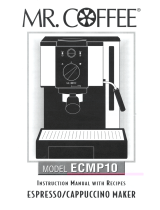ENGLISH
How to make a good Espresso coffee:
1 Follow the procedure described under
“Preparation”.
2 Select the correct filter basket (10 or 11) and
insert it in the filter holder (9).
Use the small filter for 1 cup and the large
filter for 2 cups of espresso.
Then insert the filter holder (9) into the
brewing head (11) to warm-up
3 Wait until the machine has reached the correct
temperature with filter holder inserted
(heating time of about 6 minutes).
Use this time to set table, prepare cups,
coffee, milk, etc
4 After the warm-up period, remove the warm
filter-holder (9) from the brewing head and
fill with correctly ground espresso coffee using
the measuring spoon provided.
Place one level measure of coffee in basket
for each cup of espresso. Do not overfill.
Gently tamp down coffee with the tamper
(18) provided. Do not compress too firmly.
5 Clean any excess coffee from the rim of filter
holder (9). Insert filter holder into brew head
by holding handle approximately 45
degrees to the left as you face machine. When
properly aligned,move handle firmly to the
right to lock into position.
The handle should point to the front of the
machine or slightly to the right.
6 Place one or two espresso cups on the drip
plate to line up with the spouts of the filter holder.
Depress hot water/brew switch (2) to pos. “1”.
Espresso will start to flow into cups.
7 When cups are 3/4 full, release brew switch
to “0”. The more water you allow to flow, the
weaker the coffee. When properly made, the
espresso will have a light brown foam “cre-
ma” floating on the top.
If not, refer to “In the event of faulty
function”.
8 Remove cups and serve.
9 To make more espresso, carefully and slowly
remove the filter holder by moving handle to
the left. Be careful as hot water will be on top
of the coffee grinds in the holder. Some water
will continue to drip from brewing head as
filter holder is removed. That is normal and
due to the pump pressure in the system.
Knock out used coffee grinds from filter. For
more espresso repeat steps 4 to 8 above
Preparing cappuccino:
When preparing to make a cappuccino, have
all of the ingredients at hand as well as a
frothing pitcher (or mug) halffilled with skimmed
or low-fat milk and cups that are larger (6 oz.)
than those used for espresso.
Frothing Milk:
The higher the fat content in the milk the denser
the froth will be. The Turbo-Frother (8) or milk
frother (24) will give you all the froth required
but don’t let milk come to a boil.
It may require two or three attempts to “become
an expert” but you will be successful at frothing
milk if you give it a chance. Swivel the Turbo-
Frother steam nozzle (or milk frother) slightly
outward so that you can get the frothing pitcher
under the nozzle without knocking the base of
the machine.
Turbo frother steam nozzle version:
1 Make espresso (in a large cups) as described
above
2 Position steam switch (4) to “1”.
3 After 15 to 20 seconds or, when temperature
ready-light (3) goes on, place the frothing
pitcher halffilled with low-fat milk under Tur-
bo Frother steam nozzle so that tip is just
under the surface of the milk. See Fig.03.
• 11 •
OPTIONAL
“Perfect crema” device (13)
To ensure the optimum function of the “Perfect
cream” device, insert the frothing jet device
into the filter holder.
We recommend that the “Perfect cream”
device be cleaned on a daily basis, before
use, in order to prevent any blockage of the
delivery holes. A pin may be used to clean
out the hole.
Even if the type of coffee grinding is not correct
the use of the “Perfect cream” device will pro-
duce the typical creamy froth of an espresso
coffee.
N.B.:
Only use the “perfect cream device with
a large 2-cup filter
.











